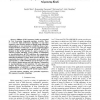125
click to vote
BMCBI
2011
14 years 7 months ago
2011
Background: It has been suggested previously that genome and proteome sequences show characteristics typical of natural-language texts such as “signature-style” word usage ind...
130
Voted
BMCBI
2010
14 years 7 months ago
2010
Background: A new paradigm of biological investigation takes advantage of technologies that produce large high throughput datasets, including genome sequences, interactions of pro...
120
Voted
BCB
2010
14 years 7 months ago
2010
Recent studies suggest that the mammalian genomes can be subdivided in segments within which there is limited haplotype diversity. Understanding the distribution and structure of ...
127
Voted
BMCBI
2010
14 years 10 months ago
2010
Background: Physical maps are the substrate of genome sequencing and map-based cloning and their construction relies on the accurate assembly of BAC clones into large contigs that...
124
Voted
BIB
2010
14 years 10 months ago
2010
Genome-wide sequencing has enabled modern biomedical research to relate more and more events in healthy as well as disease-affected cells and tissues to the genomic sequence. Now ...
113
Voted
IPPS
2010
IEEE
14 years 10 months ago
2010
IEEE
Millions of DNA sequences (reads) are generated by Next Generation Sequencing machines everyday. There is a need for high performance algorithms to map these sequences to the refer...
117
Voted
GCB
2010
Springer
14 years 10 months ago
2010
Springer
: The current high-throughput sequencing technologies produce gigabytes of data even when prokaryotic genomes are processed. In a subsequent assembly phase, the generated overlappi...
150
Voted
BMCBI
2010
14 years 11 months ago
2010
Background: A common approach to understanding the genetic basis of complex traits is through identification of associated quantitative trait loci (QTL). Fine mapping QTLs require...
111
Voted
RECOMB
2010
Springer
14 years 11 months ago
2010
Springer
An important question in genome evolution is whether there exist fragile regions (rearrangement hotspots) where chromosomal rearrangements are happening over and over again. Althou...





